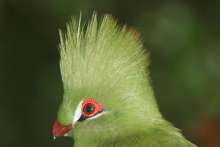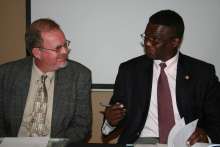New environmental research platform established for grasslands, wetlands and forests
|
The South African Environmental Observation Network (SAEON) has announced the signing of an agreement with Ezemvelo KwaZulu-Natal Wildlife. In terms of the agreement Ezemvelo KwaZulu-Natal Wildlife will host the new SAEON environmental monitoring and observation platform for grasslands, wetlands and forests.
In signing the agreement, Ezemvelo KZN CEO Khulani Mkhize emphasised his organisation’s commitment towards the node and its activities.
"Ezemvelo KZN Wildlife is looking forward to hosting the SAEON environmental monitoring and observation node for grasslands, wetlands and forests," he said, "as there are many synergistic opportunities that arise from this in terms of science, data and environmental management."
Prof Mzamo Mangaliso, CEO and President of the National Research Foundation (NRF) signed the agreement on behalf of SAEON, one of the NRF’s research facilities. Prof Mangaliso said that the new node, in combination with the network of five SAEON nodes already established throughout South Africa, will play an important role in understanding and monitoring the effects of global change, strengthening scientific research, developing crucial capacity in science and technology and informing policy-making crucial to a sustainable future.
SAEON operates as a network of distributed research platforms coordinated as nodes, with information systems for long-term, multi-disciplinary, multiple-scale and multi-institutional ecosystem studies. Nodes have already been established in almost all of South Africa’s major biomes – savannah, coastal inshore, marine offshore, fynbos and arid areas.
Landmark agreement
“This is a landmark agreement as the successful establishment of this node completes the series of nodes envisaged for the network,” says SAEON Managing Director Johan Pauw.
“Grasslands are economically and ecologically important in South Africa and are increasingly threatened by development, forestry and poor agricultural practices,” he says. Grasslands support human life with essential natural products and environmental services, and it is thus important that they remain healthy. Moreover, the grassland area in South Africa is fairly unique and is largely maintained by frequent veld fires. Further north into Africa grasslands occur in smaller, more spatially limited patches.
Despite the fact that there are considerable data sets on grasslands, these are widely scattered and often inaccessible. “SAEON would play a valuable role in consolidating the data,” explains Pauw.
Although grasslands cover 30% of South Africa and forests only 1%, forests are important research areas from a biodiversity perspective. A major cause for concern is that South Africa’s pockets of indigenous forest are shrinking. Wetlands are also covered by the node based on the observation that there are considerable problems associated with changes in and the destruction of wetlands in many of the grassland areas. This is a fundamental landscape issue associated with the large-scale anthropogenic change imposed on wetlands. Even landowners are not always aware of the damage they are causing. Urbanisation also plays a major role: the biggest impact of mushrooming cities on the natural environment is on watercourses and wetlands.
Internationally recognised for conservation and research
Pauw says that SAEON is delighted to have this opportunity of forging a stronger relationship with Ezemvelo KZN Wildlife. “The organisation is internationally recognised for its conservation and research programmes,” he explains, “and SAEON will have access to its considerable scientific capacity, environmental data and number of well-managed nature reserves.”
KwaZulu-Natal appears to be a natural home for the node, says Pauw. Apart from the fact that grasslands and forests appear in a mosaic pattern in the province, long-term studies on grasslands and pastures are ongoing in the Pietermaritzburg area. There is a critical mass of researchers in the region at organisations and institutions such as the University of KwaZulu-Natal, Cedara Agricultural Research Institute and Ezemvelo KZN Wildlife.
SAEON is already collaborating with relevant programmes run by other organizations such as the Grassland Biome project of the South African National Biodiversity Institute and the Rangeland Monitoring project of the Agricultural Research Council.
Fresh water (both groundwater and surface water) is a critical factor and should receive ongoing attention as a cross-cutting element in every node. The hydrological cycle has already been severely influenced by land use and land cover changes, and climate change will further impact upon it. This requires monitoring of high-altitude water catchments such as in the nearby Drakensberg, which will be an important site in the node’s environmental observation system.
“SAEON draws on the strengths of its partners and networks to extract the best solutions for national and regional challenges,” explains Pauw. Other node hosts are the South African National Parks (for the savanna and arid areas), the South African Institute for Aquatic Biodiversity (Coastal-inshore Node), the South African National Biodiversity Institute (Fynbos Node) and Department of Environmental Affairs and Tourism’s Marine and Coastal Management division (Marine-offshore Node).
As with all the nodes, the agreement with Ezemvelo KZN Wildlife follows a comprehensive consultative process with relevant stakeholder communities.














